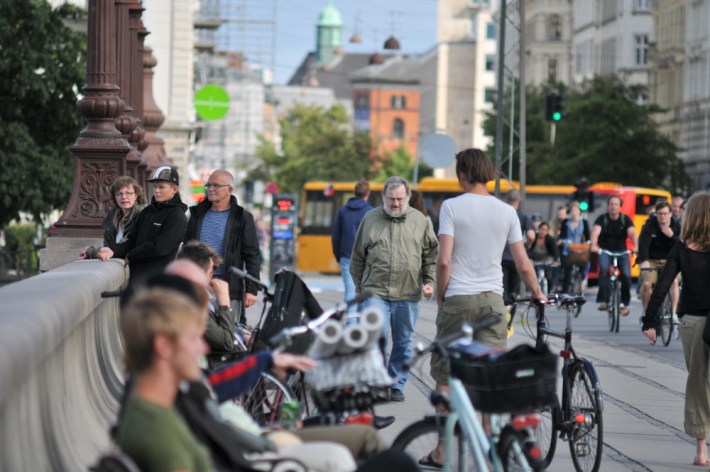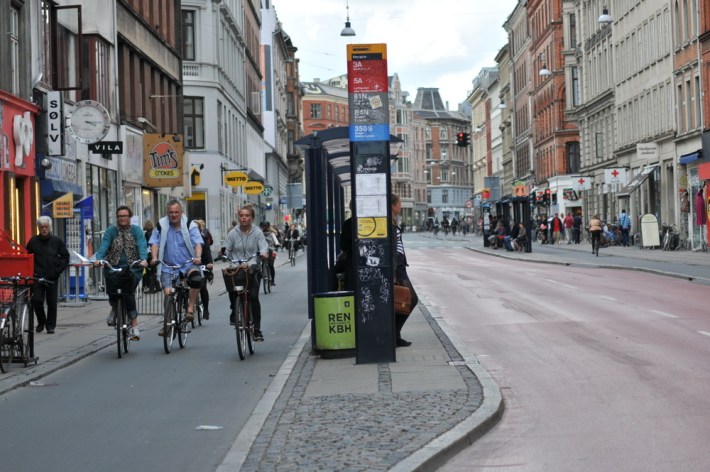Planners presented early concepts for a new Market Street to the public yesterday, moving the discussion forward on revitalizing San Francisco's grand boulevard with features like car-free zones, raised bike lanes, faster transit, and more inviting public spaces.
The ideas and visualizations, which are available on the Better Market Street website, were presented by planners as starting points to explore. Many of the concepts are hallmarks of the world's greatest streets, and planners in the multi-agency effort are aiming to adapt them to Market using a swath of survey data about how the street is used.
The increasingly popular idea of removing private autos from lower Market could come in various forms, ranging from additional forced turns for cars in both directions, to a car-free zone near the Powell Street cable car turnaround, to a full ban on cars as far west as Octavia Boulevard.
Staff fielding public feedback said the proposals have met mostly with support, with concerns focused largely on how to best implement car prohibitions in ways that are enforceable and don't shift traffic congestion problems to other streets.
Similar experiments have proven successful on New York City's Broadway and Copenhagen's Nørrebrogade, said Jeff Risom, a planner on the project with the Copenhagen-based Gehl Architects. Like Market's forced turns at eastbound Sixth and Tenth Streets, officials in those two cities used pilot projects to find the best fit for car restrictions.
In the summer of 2009, the NYC Department of Transportation (with the help of Gehl Architects) removed cars from a section of Broadway in Times Square, turning it into a pedestrian plaza. As a result, Times Square became more of a public destination, increasing pedestrian usage and simplifying the flow of vehicle traffic in Midtown Manhattan. NYC now plans to construct a permanent redesign for the plaza.
A key similarity between Market and Broadway is that they both cut diagonally through a dense street grid.
"What Broadway's been able to achieve is that you've made traffic run smoother in Midtown Manhattan while reclaiming 350,000 square feet of public space," said Risom. "We need to be able to think smart about Market Street in the same way."
As many San Franciscans know, if you're driving on Market, you're doing it wrong. In fact, Better Market Street surveys show that the majority of drivers on Market only travel two blocks and are looking for parking (which mostly doesn't exist on Market anyway). Banning cars on most of Market, supplemented with a plan for car traffic flow, could simplify navigation for drivers, who have disproportionate negative impacts on pedestrians, bicyclists, and transit.
According to project staff, 85 percent of people on Market Street get there without a car. With a quarter of transit boardings in SF taking place on Market, Risom said its abundant transit access is a unique characteristic that other cities would love to have. "You have such a latent demand of people riding transit, of pedestrians and cyclists," he said. "How can we invite them to spend more time, spend more money, spend more opportunities and contribute to this idea of civility in the city?"
While "we can't take the exact design that we did on Broadway," said Risom, "we can take a lot of the process, surveying how people use the street, paying attention to the street's most vulnerable users, in terms of pedestrians and cyclists, thinking about these win-win opportunities."
Copenhagen has also been refining designs on Nørrebrogade, a commercial and transit corridor connecting the city center to the thriving Nørrebro neighborhood. It's also claimed as the busiest bicycling street in the Western world, with 36,000 bicycles traveling on it every day.
Risom said the city downsized an initially longer car-free segment of the street after some merchants complained it would hurt their business. In the last couple of years, a bridge on the street (Nørrebrogade translates to "North Bridge Street") has become a bustling social destination after noise was reduced by diverting car traffic. The city also used paint to temporarily expand sidewalk space and bike lanes on the street. The city is in the process of making such changes permanent.
The current one-block car-free zone "totally changed the whole dynamic of the street," said Risom. These days, he said, some Nørrebrogade merchants may be regretting their initial push to reduce the car-free zone.

Market could also be graced with physically raised bike lanes, which are common in Copenhagen. Although one proposal would rebuild Market without one, mixing people on bikes with motor vehicles as they are now, there seems to be little appetite for it. Mari Hunter, a bicycle planner with the SFMTA, said attendees raised concerns about how to safely mix bicyclists and motor traffic at intersections with BART station entrances, where space is limited.
To speed up Muni lines on the street, the number of center lane stops could be reduced from the current 12 to either six or nine. Members of the SF Transit Riders Union said they haven't taken a position on either of those proposals yet.
The project is scheduled to be completed in 2015. One big question noted by city staffers is where the funding for the estimated $250 million project will come from, as only the funds for re-paving are currently secured. While much of the rest of the funding could come the Federal Transit Administration, one advocate noted the need for a plan to collect fee revenue through upzoned development along Market.
For all of the concept materials, check out the Better Market Street website. You can also join a webinar on the project this Thursday, and another public workshop will be held on Saturday.
Note: You can read more about some of the principles of urbanism behind Better Market Street from Jan Gehl, head of Gehl Architects, in a series from his book "Cities for People" featured on Streetsblog SF last year. His firm is also working on the redesign of Jefferson Street in Fisherman's Wharf.









